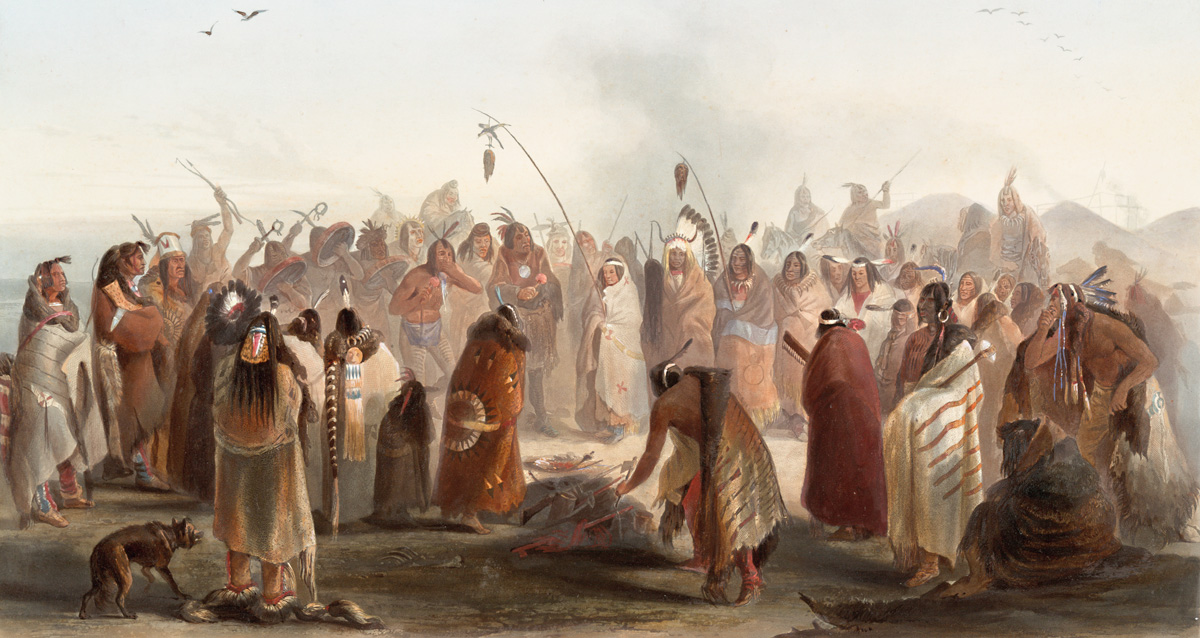Posecopsahe (Black Cat) of Ruptáre and The Coal of Mitutanka visit Fort Mandan and spend the night. At Mitutanka village, several soldiers witness a war medicine dance—perhaps the Mandan Wolf Ceremony. In a lodge at a nearby Hidatsa village, trader François-Antoine Larocque‘s ink freezes.
A War Medicine Dance
by Yellowstone Public Radio[1]Originally aired weekdays by Yellowstone Public Radio during the Bicentennial observance of 2003-2006. Narrated by Hal Hansen. Scripts by Whit Hansen and Ed Jacobson. Produced by Leni Holliman. © … Continue reading
Scalp Dance of the Minatarres
Karl Bodmer (1809–1893)
Rare Book Division, The New York Public Library.[2]“Scalptanz der Mönnitarris. Danse du scalp des indiens Meunitarris. Scalp dance of the Minatarres.” New York Public Library Digital Collections. Accessed March 5, 2019. … Continue reading
Mitutanka War Medicine Dance
verry Cold, Send out 3 men to join 3 now below & hunt,
Pose-cop se ha or Black Cat came to See us and Stay all night
Sho sa har ro ra or Coal also Stayd all night, the inturpeter oldst wife Sick, Some of our men go to See a war medison ⟨Dance⟩ made at the village on the opposit Side of the river
—William Clark
Cold Hidatsa Lodges
It is so very Cold in these Lodges, that the Ink freezes in my pen while writing, although I sit as close to the fire as I can without burning my Legs.
—François-Antoine Larocque[3]11 January 1805, W. Raymond Wood and Thomas D. Thiessen, Early Fur Trade on the Northern Plains: Canadian Traders among the Mandan and Hidatsa Indians, 1738–1818 (Norman: University of Oklahoma … Continue reading
Weather Diary
Ther. at rise
Weather Wind at rise
Thert. at 4 P.M. Weather Wind at 4 P.M. River 38 below [0] fair N W 14 below [0] fair N W fall ½ in. —Meriwether Lewis[4]To assist the reader, the editor of this web page has omitted the date column, merged the “River” columns, and spelled out some abbreviations.
Experience the Lewis and Clark Trail
The Lewis and Clark Trail Experience—our sister site at lewisandclark.travel—connects the world to people and places on the Lewis and Clark Trail.
Plan a trip related to January 11, 1805:

Fort Mandan is a High Potential Historic Site along the Lewis and Clark National Historic Trail managed by the U.S. National Park Service. The North Dakota Department of Parks and Recreation manages a modern reconstruction and the Lewis and Clark Interpretive Center located at US Hwy 83 and ND Hwy 200A.
Knife River Indian Villages National Historic Site is a High Potential Historic Site along the Lewis and Clark National Historic Trail managed by the U.S. National Park Service. A unit of the National Park System, the site is located at 564 County Road 37, one-half mile north of Stanton, North Dakota. It has exhibits, trails, and a visitor center.
Notes
| ↑1 | Originally aired weekdays by Yellowstone Public Radio during the Bicentennial observance of 2003-2006. Narrated by Hal Hansen. Scripts by Whit Hansen and Ed Jacobson. Produced by Leni Holliman. © 2003 by Yellowstone Public Radio. |
|---|---|
| ↑2 | “Scalptanz der Mönnitarris. Danse du scalp des indiens Meunitarris. Scalp dance of the Minatarres.” New York Public Library Digital Collections. Accessed March 5, 2019. https://digitalcollections.nypl.org/items/510d47da-c450-a3d9-e040-e00a18064a99. |
| ↑3 | 11 January 1805, W. Raymond Wood and Thomas D. Thiessen, Early Fur Trade on the Northern Plains: Canadian Traders among the Mandan and Hidatsa Indians, 1738–1818 (Norman: University of Oklahoma Press, 1985), 148. |
| ↑4 | To assist the reader, the editor of this web page has omitted the date column, merged the “River” columns, and spelled out some abbreviations. |



